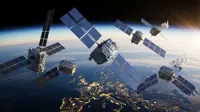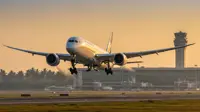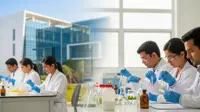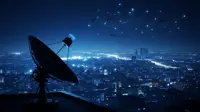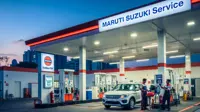Action-packed Day 2 for discovery astronauts
02 Jun 2008
When space shuttle Discovery was launched for the International Space Station (ISS) two days ago, it was carrying, (and still is), the largest payload delivered till date to the international orbiting outpost, a $1-billion component for the Japanese Kibo space laboratory. (Kibo means hope in Japanese).
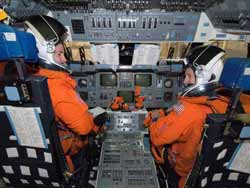 |
| STS-124 Commander Mark Kelly (left) and Pilot Kenneth Ham, participate in a training session in the crew compartment trainer in the Space Vehicle Mockup Facility at Johnson Space Center. |
| Kelly and Ham are wearing training versions of their shuttle launch and entry suits. |
| Photo credit: NASA/JSC |
Discovery is already on its third day in space after blasting off from the Kennedy Space Center, Cape Canaveral on Saturday, and its seven-member crew completed an inspection of the spacecraft's wings yesterday, looking for any signs of damage after the fiery launch.
Usually on a shuttle's second day in space, astronauts use a 50-foot laser-tipped boom attached to a robotic arm to conduct a meticulous, slow-motion inspection of the spacecraft's wings and nose - the shuttle's most vulnerable areas - for any signs of launch damage. It's become a routine safety procedure ever since the 2003 Columbia accident that killed Kalpana Chawla and her colleagues.
However, this time round, due to the massive payload, there hasn't been enough room to accommodate the boom. Without it, the Discovery's robotic arm was only able to do a partial survey of the thermal protection system, limited to looking at the shuttle's wings. The inspection began early Sunday afternoon and lasted less than two hours. Engineers on the ground were set to review the data.
A more thorough inspection is planned at the halfway point as well as near the end of the 14-day mission after Discovery's crew retrieves a laser-tipped boom left behind at the space station by the Endeavour's astronauts when they visited the ISS in March.
The centerpiece of the mission will be the delivery and installation of the bus-sized Japanese laboratory, which measures 11.2 meters (36.7 feet) and weighs 14.8 tonnes (32,600 pounds). Japanese astronaut Akihiko Hoshide, also flying aboard Discovery, will supervise the process.
It is the second of three missions to take up key components of Kibo which will host experiments in space medicine, biology and biotechnology, material production, and communications. When in place, it will be the single largest room on the ISS, with space for four scientists to work. Experiments are due to start in August and about 100 are scheduled to have been conducted by 2010.
Another piece of equipment of the $2.8-billion Japanese contribution to the ISS, a 10-meter (33-foot) robotic arm, is also going up with the Discovery, for use in Kibo experiments and maintenance tasks.
Kibo's third main section, a "terrace" outside the pressure module being delivered this time and completely exposed to outer space, is to be delivered by a shuttle flight in March 2009.
Three spacewalks are also planned for the mission, including one in which an astronaut will attach himself to a massive robotic arm for a soaring, 20-minute ride through space to replace a depleted nitrogen tank, in a giant arc NASA officials described as a "windshield wiper motion."
Astronauts will also inspect damage to a key joint that helps the station's power-generating solar arrays to follow the sun while the space station's two Russian residents will put in the new toilet pump.
Besides transporting equipment, the Discovery will also effect crew transfers this time round. One of its astronauts, Gregory Chamitoff, will move into the space station for a six-month stay. He'll replace Garrett Reisman, who will return to Earth aboard the shuttle.
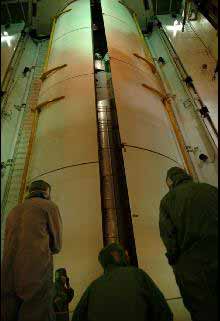 |
| Workers in the payload changeout room on Launch Pad 39A watch closely as space shuttle Discovery's payload bay doors close around the Japanese Experiment Module - Pressurized Module. |
| Photo credit: NASA/Kim Shiflett |
The Space Station is a research facility currently being assembled in space. The on-orbit assembly of ISS began in 1998. The space station is in a low Earth orbit and can be seen from Earth with the naked eye: it has an altitude of approximately 350 km (217 miles) above the surface of the Earth, and travels at an average speed of 27,700 km (17,210 statute miles) per hour, completing 15.77 orbits per day.
The ISS is a joint project among the space agencies of the United States (NASA), Russia (RKA), Japan (JAXA), Canada (CSA) and eleven European countries (ESA). The Brazilian Space Agency (AEB, Brazil) participates through a separate contract with NASA. The Italian Space Agency similarly has separate contracts for various activities not done in the framework of ESA's ISS works (where Italy also fully participates).
The ISS is a continuation of several other previously planned space stations: Russia's Mir 2, the US Space Station Freedom, the European Columbus, and Kibo, the Japanese Experiment Module. The projected completion date is 2010, with the station remaining in operation until around 2016. As of 2008, the ISS is larger than any previous space station.
The ISS has been continuously manned since the first resident crew entered the station on 2 November 2000, thereby providing a permanent human presence in space. The crew of Expedition 17 is currently aboard. At present the station has a capacity for a crew of three.
In order to fulfill an active research program it will eventually hold 6 crew members. Early crew members all came from the Russian and US space programs. German ESA astronaut Thomas Reiter joined the Expedition 13 crew in July 2006, becoming the first crew member from another space agency. The station has, however, been visited by astronauts from 16 countries. The ISS was also the destination of the first five space tourists.
At an estimated cost of $156 billion (~€100 billion) for the ISS project from its start until the programme's end in 2017, the ISS will be the most expensive object ever built by humankind.
